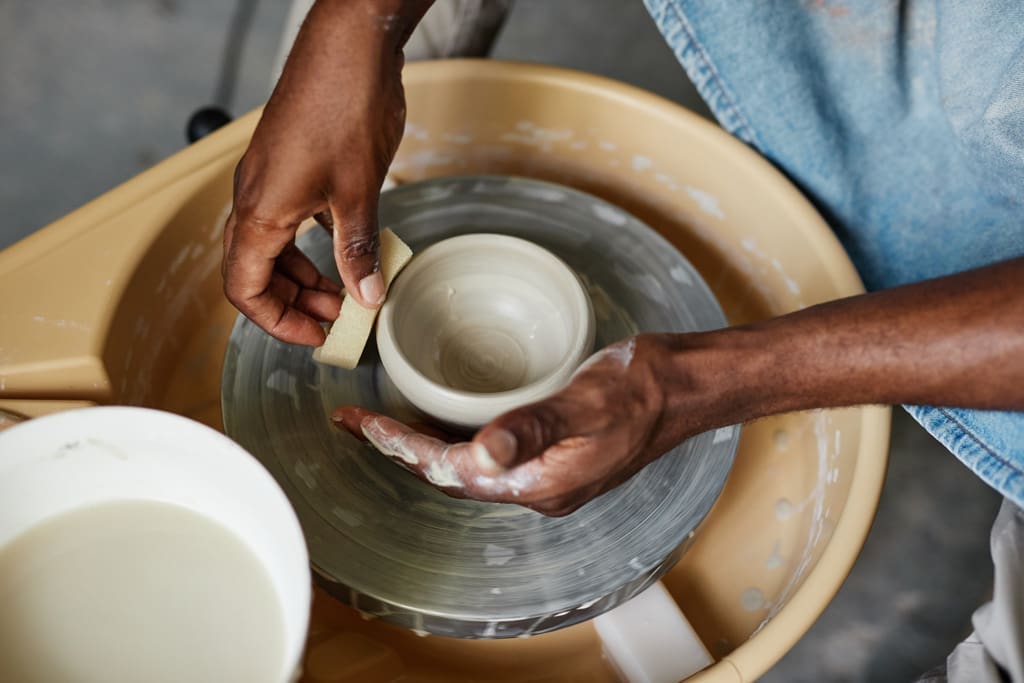
What is Art Therapy?
Art therapy is a form of psychotherapy that utilizes various forms of art-making. It supports clients in exploring and expressing their emotions, thoughts, and experiences.
Healing with art therapy is often facilitated by a licensed art therapist. It can be used with individuals, groups, families, and communities.
What Does Healing With Art Therapy Involve?
Art therapy involves creating art in a supportive and non-judgmental environment. Clients are encouraged to express themselves freely and explore their inner worlds.
The art-making process itself can be therapeutic. It allows clients to access emotions and experiences that may be difficult to put into words.
Through creating art and reflecting on the process, clients can gain insight into their thoughts, feelings, and behaviors and work towards personal growth and healing.
Forms of Art Therapy
Art therapy can take many forms, including:
- Drawing
- Painting
- Sculpture
- Collage
- Other forms of visual art
It can also involve creative writing, poetry, music, and dance. The specific form of art-making is tailored to the client’s needs and interests.
What Can Art Therapy Treat?
Art therapy is effective in treating a variety of mental health conditions, including:
- Anxiety
- Depression
- Trauma
- Addiction
Healing with art therapy can also be used to support personal growth and self-exploration. It enhances creativity and promotes overall well-being.
Is Art Therapy Effective on Its Own?
While healing with art therapy can be a helpful tool in supporting mental health, it is not a substitute for professional mental health treatment.
Clients should always consult with a licensed mental health professional. They help you determine the best course of treatment for healing with art therapy.
How Can Art Therapy Be Used for Healing and Emotional Growth?
Art therapy can help people express and process difficult emotions and experiences. These may be emotions that are difficult to verbalize.
The creative process of making art can help individuals access their emotions. Then, they gain insight into their thoughts, feelings, and behaviors.
Through this process, people can develop a greater understanding of themselves. They learn about their experiences and their relationships with others.
Promotes Emotional Regulation and Stress Reduction
Art therapy can also be used to promote emotional regulation and stress reduction. The act of creating art can be soothing. It allows individuals to relax and feel more grounded.
Additionally, the sensory experience of working with art materials can be grounding. It can help individuals focus on the present moment. This can reduce anxiety and overwhelming emotions.
Supports Personal Growth and Exploration
Healing with art therapy can also support personal growth and self-exploration. Through making art and reflecting on their creations, people can gain insight into their strengths, values, and aspirations.
They can also explore areas of their life that may be causing them distress or holding them back and work towards personal growth and positive change.
The Power of Art Therapy
Healing with art therapy is a powerful tool for healing and emotional growth. It allows individuals to access their inner worlds. You gain insight into your experiences and develop new coping strategies.
You also find ways of relating to yourself and others. Healing with art therapy may be used in conjunction with other forms of therapy and treatment.
Individuals should always consult with a licensed mental health professional. They determine the best course of treatment for their individual needs.
What Types of Emotional or Psychological Challenges Can Art Therapy Help With?
Art therapy can help with many emotional or psychological challenges, including:
- Anxiety
- Depression
- Trauma
- Post-traumatic stress disorder (PTSD)
- Substance abuse and addiction
- Eating disorders
- Grief and loss
- Chronic pain and illness
- Autism spectrum disorders
- Attention deficit hyperactivity disorder (ADHD)
- Relationship issues
- Low self-esteem and self-worth
- Anger management
- Stress and burnout
- Sleep difficulties
Art Therapy and Meeting Goals
Art therapy can also be beneficial for individuals who want to:
- Explore their emotions and inner worlds
- Develop new coping strategies
- Enhance their overall well-being
How Does Art Therapy Support The Healing Process?
Art therapy supports the healing process by providing a safe and non-judgmental space. Healing with art therapy allows individuals to explore their emotions and experiences.
The creative process of making art can be therapeutic in and of itself. It allows individuals to express themselves in a way that may be difficult to put into words.
Through the act of creating art, individuals can:
- Process their emotions
- Gain insight into their thoughts and feelings
- Develop new coping strategies and ways of relating to themselves and others
The Role of Creativity in Art Therapy
The role of creativity in art therapy is essential. Creativity is not only about making something beautiful or impressive. It is also about tapping into imagination and exploring new possibilities.
Through creative expression, individuals can access parts of themselves that may have been buried or ignored. This can be particularly helpful for individuals who struggle with emotional expression or have experienced trauma or other forms of distress.
The art-making process can also be empowering. Healing with art therapy allows individuals to create something tangible that represents their experiences and emotions.
What Are The Potential Benefits Of Healing With Art Therapy?
Some potential benefits of healing with art therapy include:
- Improved emotional regulation and stress reduction
- Increased self-awareness and self-esteem
- Improved communication and interpersonal skills
- Increased ability to manage symptoms of anxiety, depression, and other emotional or psychological challenges
- Improved coping strategies and problem-solving skills
- Greater sense of control and empowerment
- Increased ability to express and process traumatic experiences
- Development of new insights and perspectives on life experiences
- Increased ability to experience pleasure and joy in life
- Improved overall well-being and quality of life
How Effective is Art Therapy Compared to Other Forms of Treatment?
The effectiveness of healing with art therapy varies compared to other forms of treatment. Some studies have shown that art therapy can be as effective as other forms of therapy.
Some other therapies include talk therapy or cognitive-behavioral therapy. Still, art therapy is effective for specific populations and conditions.
Art Therapy as a Supplemental Treatment
Healing with art therapy is best in conjunction with other forms of treatment. Individuals should always consult with a licensed mental health professional.
The benefits of art therapy depend on the individual’s willingness and ability to engage in the creative process and the skills and expertise of the art therapist.
How Can Someone Use Art Therapy To Address Trauma Or Difficult Emotions In A Safe And Supportive Environment?
Art therapy can be an effective tool for individuals who have experienced trauma or are struggling with difficult emotions. It provides a safe and supportive environment to explore and express their feelings without verbal communication.
Here are some ways healing with art therapy works to address trauma or difficult emotions.
Creating a Safe Space
Art therapy can provide a safe and non-judgmental space. The therapist can work with the client to create a comfortable environment.
This environment feels safe and supportive. It allows the individual to feel more open to the creative process.
Encouraging Self-Expression
Art therapy allows individuals to express themselves comfortably and naturally. The therapist can encourage self-expression through various art-making materials and techniques. They include painting, drawing, and sculpture.
Processing Traumatic Experiences
Art therapy can provide a way for individuals to process traumatic experiences and emotions in a non-threatening way.
The therapist can help the individual explore their feelings and experiences through art. Then, they process the artwork with the client to help them make sense of their emotions and experiences.
Promoting Relaxation and Stress Reduction
Art therapy can be a relaxing and calming experience. It helps individuals reduce stress and anxiety.
The therapist can guide the individual through mindfulness exercises and relaxation techniques. This takes place while they engage in the creative process.
Building Self-Esteem and Self-Awareness
Art therapy can help individuals build self-esteem and self-awareness. It allows them to express themselves creatively. They also gain insight into their thoughts and feelings.
How Does the Therapeutic Relationship Between the Art Therapist and Client Support the Healing Process in Art Therapy?
The therapeutic relationship between the art therapist and client is an essential component of healing with art therapy. It is based on the principles of trust, empathy, and non-judgment.
It provides a safe and supportive environment for individuals to explore their emotions and experiences.
Importance of the Therapeutic Relationship
The art therapist works with the client to establish a rapport and create a therapeutic alliance that fosters a sense of safety and trust. The therapist listens attentively and provides validation. Then, they encourage the client to explore their thoughts and feelings through the creative process.
Through this relationship, the art therapist can help the client to feel understood, supported, and validated. This can be particularly helpful for individuals who have experienced trauma or emotional distress. They may have difficulty trusting others or expressing their emotions.
Therapists Provide Framework for Art Therapy Processes
The therapeutic relationship also provides a framework for the art therapy process. The art therapist guides the client through the creative process. They provide support and feedback as needed.
The therapist may also help the client explore their artwork’s meaning and symbolism and connect their art-making to their emotions and experiences.
What Should Someone Expect During an Art Therapy Session?
While healing with art therapy, the client will typically work with the art therapist to engage in a creative process. It can include various art materials such as paints, clay, markers, and collage.
The therapist will provide a safe and supportive environment for the client. Here, they explore their emotions and experiences through the art-making process.
What the Art Therapist Will Do
The experience of art therapy is tailored to the individual needs and circumstances of each client. The art therapist will work with the client to:
Identify their goals for therapy
Develop an individualized treatment plan
How is the Experience Tailored to the Individual Needs and Circumstances of Each Client?
The process always considers their unique strengths, challenges, and preferences. The therapist may use a variety of art-based interventions to help the client achieve their therapeutic goals.
They include:
- Guided imagery
- Visualization
- Specific art-making exercises
Verbal Techniques
The therapist may also use various verbal techniques to help the client explore the meaning and symbolism of their artwork.
They include:
- Reflective listening
- Questioning
- Interpretation
The experience of art therapy is highly individualized. Depending on the client’s needs and goals, it may vary from session to session.
The art therapist may adapt the session based on the client’s mood, level of engagement, or progress in therapy.
A Safe Environment to Heal
You can expect a safe and supportive environment to explore their emotions and experiences. Healing with art therapy gives you a great creative process during the art therapy session.
The healing with art therapy experience is also tailored to their needs and circumstances.

How Can True Life Care Help with Art Therapy and Healing?
True Life Care Center is a mental health organization providing various services. Our services support individuals with emotional, behavioral, and mental health challenges.
One of the services offered by True Life Care is healing with art therapy. It can be a powerful tool for healing and personal growth.
Our Art Therapy Program
True Life Care’s art therapy program is designed to provide individuals with a safe and supportive environment. Here, they explore their emotions and experiences through the creative process.
The program is led by licensed art therapists who are trained to work with individuals with a variety of mental health conditions, including:
- Depression
- Anxiety
- Trauma
- Addiction
Individualized Treatment
The art therapy program at True Life Care is highly individualized. It is tailored to the unique needs and circumstances of each client.
The art therapists work closely with clients to develop treatment goals and a personalized treatment plan. They may include a variety of art-based interventions and techniques.
In addition to individual art therapy sessions, True Life Care also offers group art therapy sessions. These healing art therapy sessions allow clients to connect with others. They share their experiences in a supportive and non-judgmental environment.
Comprehensive Treatment Approach
True Life Care’s art therapy program is part of a comprehensive treatment approach that may also include the following:
- Medication management
- Talk therapy
- Other evidence-based interventions
Contact True Life Care Today
At True Life Care, we are committed to providing high-quality, compassionate care to individuals seeking support for their mental health concerns.
Reach out to us today for more information about our art therapy treatment program in New Jersey.
Resources
- https://pubmed.ncbi.nlm.nih.gov/31747178/
- https://pubmed.ncbi.nlm.nih.gov/34456801/
- https://www.sciencedirect.com/science/article/abs/pii/S0197455615000696
- https://systematicreviewsjournal.biomedcentral.com/articles/10.1186/s13643-022-01976-7
- https://pubmed.ncbi.nlm.nih.gov/36895711/
- https://bmcpsychiatry.biomedcentral.com/articles/10.1186/s12888-015-0528-4
- https://pubmed.ncbi.nlm.nih.gov/34335345/
















